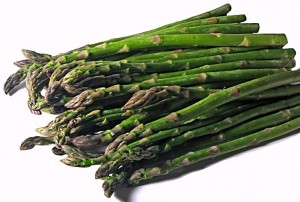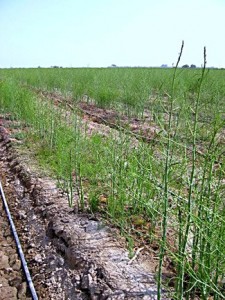 Asparagus is a flowering plant that has been widely cultivated as a vegetable crop. Asparagus can grow up to 100–150 centimeters tall, with stout larissa stems with much-branched feathery foliage. The portion of asparagus that is eaten is the immature shoot, which is often referred to as an ‘asparagus spear’ for its spear-like shape. Only the young shoots of asparagus are eaten.
Asparagus is a flowering plant that has been widely cultivated as a vegetable crop. Asparagus can grow up to 100–150 centimeters tall, with stout larissa stems with much-branched feathery foliage. The portion of asparagus that is eaten is the immature shoot, which is often referred to as an ‘asparagus spear’ for its spear-like shape. Only the young shoots of asparagus are eaten.
Asparagus is low in calories, contains no cholesterol and is healthy as it is very low in sodium. It is also a good source of vitamin B6, calcium, magnesium and zinc, and a very good source of dietary fiber, protein, vitamin A, vitamin C, vitamin E, vitamin K, thiamin, riboflavin, rutin, niacin, folic acid, iron, phosphorus, potassium, copper, manganese and selenium. The amino acid asparagine gets its name from asparagus, the asparagus plant being rich in this compound.
Green asparagus is eaten worldwide, the shoots are prepared and served in a number of ways. In the Phlippines, Asparagus is often stir-fried with chicken, shrimp, or beef, and also wrapped in bacon. Asparagus may also be quickly grilled over charcoal or hardwood embers. It is also used as an ingredient in some stews and soups. It may even be used in a dessert. The best asparagus tends to be early growth (meaning first of the season) and is often simply steamed and served along with melted butter. Asparagus can also be pickled and stored for several years.
Asparagus needs a sunny area (at least 4-6 hours) with highly organic soil, and well drained. It is long lasting will return each year so and should be considered a permanent part of your garden area. Therefore, the plantings will need to be in an area that is “out of the way” of your normal gardening activities.
Prepare the bed for planting asparagus in the fall. Soil pH factor should be at least 6.5; you may add lime to raise this factor. To determine your soil pH level check with your local college extension center. The soil will need to be loosened to at least 12 inches. Asparagus roots very deeply and will need this much depth to establish well. Add manure, or compost with lime and fertilizer.
Asparagus can be started from seed; it will take about 6 weeks to sprout. Transplant the seedlings to garden in early spring. It is easy and most common; to buy plants to set out in your garden. You purchase “crowns” the one year old is the most economical to buy and will produce comparatively as well as the two year crowns.
- Rows should be up 6 ft apart, and the crowns planted 16 inches apart.
- Place the crowns 4-6 inches into the trench (row).
- Cover crowns with soil and do not tamp down. Add soil to the furrow as the shoots begin to push their heads out of the soil. Do not totally bury the emerging plant.
- About half way throughout the planting season, this will form a crest of about 5-6 inches high and up to 2 feet wide over the crown tips. Keep this ridge during the duration of the planting process
- If your soil is heavy with clay, you may gain some edge by creating raised beds for your asparagus.
- Traditionally is recommended not to harvest until the third year after planting. Check for suggestions on harvesting in your area, at your local extension service or garden supply retailer.
How to grow Asparagus

Feed your asparagus.
Fertilize each year to keep vigorous plants, after harvest with 5-10-10 according to directions. Fertilizing promotes fern growth, which store food for the following season’s crop. Well rotted manure works well as an alternative. In early spring-clean up stalks from last season and then hoe or cultivate around the plants. Mulching is a good way to control weeds or simply hoeing. Limit herbicide usage.
Harvest.
Harvest about every other day when spears begin to develop and grow to 6 inches or more high. Snap the spears off at or near the ground level. Harvest early in the morning if possible.
Bugs
Beetles, both spotted and the asparagus beetle is damaging to asparagus. This beetle winters in trash around the garden area. When the spears emerge in spring the adults will attack and feed upon the new spears. Handpick the adults before eggs are laid. If damage has occurred, you can spray with the chemical Seven. Use caution and follow label instructions.
Source: www.essortment.com; Photos: seedfest.co.uk and kitchenproject.com